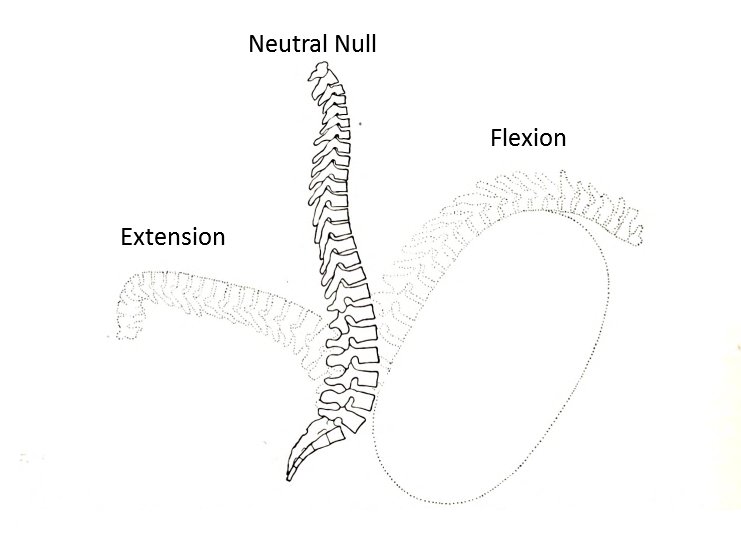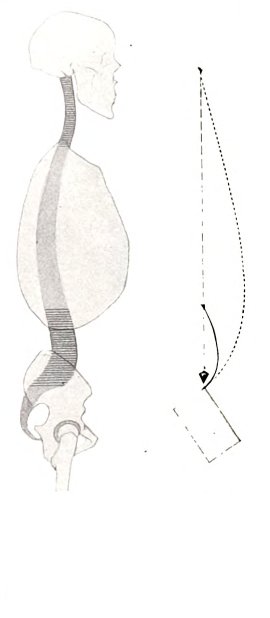yogabook / joints / vertebrae / spine
Spine
A flexible, mainly bony structure made up of many vertebrae and extending from the sacrum to the skull. Two vertebrae form a spinal segment with the intervertebral disc between them (with the exception of the segment of the atlas (C1) and axis (C2), where there are no intervertebral discs). The spinal column is traversed and surrounded by several ligaments that stabilize it and limit the displacement of the vertebrae against each other and is held and moved by various muscles, or these move ribs or extremities from the spinal column. The spine offers three dimensions of movement: Rotation, lateral flexion and extension/flexion, each of which can be performed independently in the three major areas of the spine: the cervical spine (cervical spine), thoracic spine (thoracic spine) and lumbar spine (lumbar spine). It is therefore possible for people to move their spine independently in all three dimensions of movement in these areas; for example, they can rotate the lumbar spine to the right, extend it and flex it to the left, rotate the thoracic spine (to a more limited extent) to the left, flex it and flex it to the right, and rotate the cervical spine to the right, extend it and flex it to the left. Categorically (i.e. regardless of the extent), the spine can therefore move in each of the three areas in three dimensions in two directions each (or not move as a third categorical possibility), which combinatorially results in 3 to the power of 3 * 3 to the power of 3 * 3 to the power of 3 = 19683 possibilities for the posture of the spine, whereby not all of them can be assumed to the same extent due to the course of the autochthonous back muscles and other trunk muscles. For comparison: if only the four parts of the extremities attached to the trunk are considered, i.e. 2 upper arms and 2 thighs, each with the three movement dimensions of rotation, abduction/adduction (to the lateral), abduction/adduction to the front and 4 different movement dimensions (1. full deflection in the less pronounced direction of movement, i.e. endorotation, adduction, extension, 2. Neutral zero conform, 3. 90° in each case and 4. 180°, alternatively full deflection in the more pronounced direction of movement, i.e. exorotation, abduction, flexion), this results in * 4 to the power of 3 * 4 to the power of 3 * 4 to the power of 3 * 4 to the power of 3 = 4 to the power of 12 = 2 to the power of 24, i.e. 16,777,216 possibilities. Excluding mid-limb joints and distal limb joints such as the wrist and ankle, toe and finger joints, this already allows 330,225,942,528, i.e. almost a third of a trillion body positions, some of which are the same, however, because this derivation does not take into account the fact that, for example, 180° lateral abduction plus exorotation of an arm is the same position as 180° frontal abduction. Roughly speaking, in order to try out all these positions with a frequency of one posture per second up to the current date, we would have had to start at the end of the last ice age. This number is significantly greater than the number of people who lived after the last ice age. If you now add three axes of movement (tilting forwards/backwards, tilting sideways, rotation in the plane) in space, each with 45° steps (i.e. 360/45 = 8 steps), this number increases by a factor of 8 to the power of 3, i.e. 4096 to 1,352,605,460,594,688, i.e. 1.3 quadrillion possibilities, most of which are admittedly not statically stable. With the addition of the middle joints of the extremities, i.e. the elbow and knee joints, each with 3 positions (extended, 90° flexed, maximum flexed), the number increases by a factor of 3 to the power of 4, i.e. 81, with the foot and wrist joints by another 81 under the same assumptions, making 8,874,444,426,961,747,968, i.e. 8.8 trillion. The total world population since the last ice age can be generously estimated at 120 billion, which means that all humans would have had to perform around 100 million new postures (including double and statically unstable postures) in their lifetime in order to „exploit“ the potential of the human musculoskeletal system. Back to the spine. This generally contains 7 vertebrae in the cervical spine, 12 in the thoracic spine and 5 in the lumbar spine, plus the sacrum as a former 5 vertebrae in evolutionary terms (recognizable by the 4 holes on each side) and the coccyx as 4 former vertebrae. The sacrum is connected via the sacroiliac joints to the iliac bones, i.e. the hip bone in adults, and transfers the partial body weight carried by the spine to the pelvis. At the other end, the skull rests on the spine. Sacralization of lumbar vertebrae, or the opposite, lumbarization of sacral vertebrae are not uncommon, also a deviation from the „normal“ total of 33, usually upwards.

Maximum flexibility

The WS as a weight-loaded free-swinging spring

